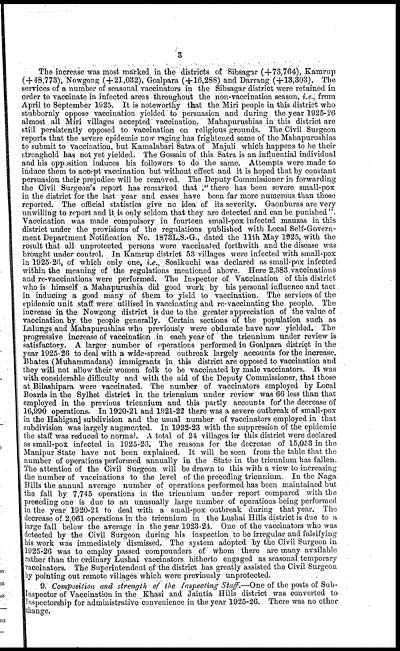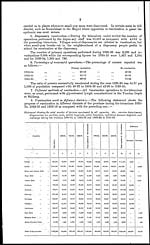Medicine - Vaccination > 1874-1927 - Annual vaccination report of the province of Assam > Vaccination report Assam 1896-1927 > 1923-1926 - Triennial vaccination report of the Province of Assam for 1923-24, 1924-25 & 1925-26
(635) Page 3
Download files
Individual page:
Thumbnail gallery: Grid view | List view

3
The increase was most marked in the districts of Sibsagar (+73,764), Kamrup
(+48,773), Nowgong (+21,032), Goalpara (+16,288) and Darrang (+13,303). The
services of a number of seasonal vaccinators in the Sibsagar district were retained in
order to vaccinate in infected areas throughout the non-vaccination season, i.e., from
April to September 1925. It is noteworthy that the Miri people in this district who
stubbornly oppose vaccination yielded to persuasion and during the year 1925-26
almost all Miri villages accepted vaccination. Mahapurushias in this district are
still persistently opposed to vaccination on religious grounds. The Civil Surgeon
reports that the severe epidemic now raging has frightened some of the Mahapurushias
to submit to vaccination, but Kamalabari Satra of Majuli which happens to be their
stronghold has not yet yielded. The Gossain of this Satra is an influential individual
and his opposition induces his followers to do the same. Attempts were made to
induce them to accept vaccination but without effect and it is hoped that by constant
persuasion their prejudice will be removed. The Deputy Commissioner in forwarding
the Civil Surgeon's report has remarked that " there has been severe small-pox
in the district for the last year and cases have been far more numerous than those
reported. The official statistics give no idea of its severity. Gaonburas are very
unwilling to report and it is only seldom that they are detected and can be punished".
Vaccination was made compulsory in fourteen small-pox infected mauzas in this
district under the provisions of the regulations published with Local Self-Govern-
ment Department Notification No. 1873L.S.-G., dated the 11th May 1925, with the
result that all unprotected persons were vaccinated forthwith and the disease was
brought under control. In Kamrup district 53 villages were infected with small-pox
in 1925-26, of which only one, i.e., Soalkuchi was declared as small-pox infected
within the meaning of the regulations mentioned above. Here 2,383 vaccinations
and re-vaccinations were performed. The Inspector of Vaccination of this district
who is himself a Mahapurushia did good work by his personal influence and tact
in inducing a good many of them to yield to vaccination. The services of the
epidemic unit staff were utilised in vaccinating and re-vaccinating the people. The
increase in the Nowgong district is due to the greater appreciation of the value of
vaccination by the people generally. Certain sections of the population such as
Lalungs and Mahapurushias who previously were obdurate have now yielded. The
progressive increase of vaccination in each year of the triennium under review is
satisfactory. A larger number of operations performed in Goalpara district in the
year 1925-26 to deal with a wide-spread outbreak largely accounts for the increase.
Bhatea (Muhammadans) immigrants in this district are opposed to vaccination and
they will not allow their women folk to be vaccinated by male vaccinators. It was
with considerable difficulty and with the aid of the Deputy Commissioner, that those
at Bilashipara were vaccinated. The number of vaccinators employed by Local
Boards in the Sylhet district in the triennium under review was 66 less than that
employed in the previous triennium and this partly accounts for the decrease of
16,990 operations. In 1920-21 and 1921-22 there was a severe outbreak of small-pox
in the Habiganj subdivision and the usual number of vaccinators employed in that
subdivision was largely augmented. In 1922-23 with the suppression of the epidemic
the staff was reduced to normal. A total of 24 villages in this district were declared
as small-pox infected in 1925-26. The reasons for the decrease of 15,053 in the
Manipur State have not been explained. It will be seen from the table that the
number of operations performed annually in the State in the triennium has fallen.
The attention of the Civil Surgeon will be drawn to this with a view to increasing
the number of vaccinations to the level of the preceding triennium. In the Naga
Hills the annual average number of operations performed has been maintained but
the fall by 7,745 operations in the triennium under report compared with the
preceding one is due to an unusually large number of operations being performed
in the year 1920-21 to deal with a small-pox outbreak during that year. The
decrease of 2,061 operations in the triennium in the Lushai Hills district is due to a
large fall below the average in the year 1923-24. One of the vaccinators who was
detected by the Civil Surgeon during his inspection to be irregular and falsifying
his work was immediately dismissed. The system adopted by the Civil Surgeon in
1925-26 was to employ passed compounders of whom there are many available
rather than the ordinary Lushai vaccinators hitherto engaged as seasonal temporary
vaccinators. The Superintendent of the district has greatly assisted the Civil Surgeon
by pointing out remote villages which were previously unprotected.
9. Composition and strength of the Inspecting Staff.—One of the posts of Sub-
Inspector of Vaccination in the Khasi and Jaintia Hills district was converted to
Inspectorship for administrative convenience in the year 1925-26. There was no other
change.
Set display mode to: Large image | Zoom image | Transcription
Images and transcriptions on this page, including medium image downloads, may be used under the Creative Commons Attribution 4.0 International Licence unless otherwise stated. ![]()
| Permanent URL | https://digital.nls.uk/91528164 |
|---|
| Additional NLS resources: | |
|---|---|
| Attribution and copyright: |
|
|---|




